During my 18-year career I’ve watched hundreds of videos of line of duty officer actions. I’ve even got a few of mine that I’ve transferred to DVD from the old VHS tapes. Whether the officers prevailed or evil overcame, each of those videos have been beneficial in reminding us of the threats that can materialize at any moment. There are perhaps no greater training aids available.
This video of a melee between Cottonwood, Arizona police, and a family committed to resistance. This nearly 8-minute brawl will ultimately involve every level of force on the continuum, including an officer-involved shooting, and demonstrates trauma care. Despite the gut-wrenching results, this video is truly an amazing educational and training opportunity.
History of the Call
There is still limited information about the circumstances leading up to this incredible fight, but here is what has been reported so far by local and national media, as well as the Arizona Department of Public Safety. Arizona DPS had taken the lead in the investigation.
Cottonwood Police received a call from Wal-Mart employees at 2352 hours after an employee had been assaulted and pushed to the ground by several members of the Gaver family near a restroom. After the initial assault, the 9-member family left the store and went to their older Suburban parked in the parking lot. Apparently, the family had been “camping” in the parking lot for at least four days. (If you are not aware, Wal-Mart has a policy to allow people to “camp” in their parking lot for safety reasons).
There is no report so far to determine if the family was suspected of committing a crime inside Wal-Mart (like shoplifting), that may have led to Wal-Mart employees attempting to make contact to investigate. The only fact reported is that an employee was assaulted and pushed to the ground by several family members near or inside a restroom.
Additional Wal-Mart employees followed the family to the parking lot, where another employee was assaulted by one of the family members. The first two Cottonwood Police officers arrived and confronted the family in the parking lot. Two additional officers arrive to assist, and approach the family from the opposite side of the family than the original two officers.
The Beginning of the Brawl
One of the newly arrived officers can be heard saying “we need to separate these folks and talk to them” (0:26). One of the adult male family members immediately responds, “no you’re not going to separate me from my family”. Several male family members can be seen confronting the officers, and an officer states, “then we’re going to go to handcuffs.” The all-out melee begins between all four officers and at least six of the family members begins.
TRAINING POINT: It is rarely a good idea to telegraph your moves or intentions. By announcing “then we’re going to handcuffs” to a group that has already announced they are “not” going to be separated, the officer gave an advanced warning to what was coming, and as seen in the video, the committed family responded accordingly.
Within (6) seconds two officers have been pushed, another punched in the face, and two officers have wrestled family members to the ground. Amazingly (and thankfully for the officers), it appears the Wal-Mart employee (large W/M in T-shirt) begins fighting with the male family member (who started in the dark jacket), and was the one who stated “no you’re not going to separate me from my family”. Had that not happened this scenario very likely would have played out much worse for the officers and family.
Fists, Kicks, Trips, and Taser!
The brawl starts so quickly the use of less-lethal devices like O.C. spray and Taser are not possible. The officers go to hands-on control after receiving verbal non-compliance (what almost every Department would expect as a first action). However, this completely committed family, immediately responds with physical force and assault.
Officers get pushed, punched, kicked, tripped, and are in a full on fight for their lives in that simple 10-second time frame from the arrival of the two additional officers, and the beginning of physical attack. Initially the officers use their physical tools (hands, arms, legs, and feet) to try to control the aggressive family. Unfortunately, as the video shows, each officer is fighting at least one family member and is unable to assist other officers. A committed adversary can be very difficult to overcome by one officer.
TRAINING POINT: Famed martial arts master Bruce Lee stated, “a fight is not won by one punch or kick, either learn to endure or hire a bodyguard”. As can be seen by this video, each officer throws numerous punches and kicks, but the dedicated and motivated combatants stay in the fight, and even land several of their own. Officers need to have pre-determined plans on how to overcome such resistance, and not hesitate to execute them. Here the officers went through the litany of less lethal options with only minimal success. Sometimes a tactical withdrawal in force is the best course of action until the Calvary arrives.
At just 0:50 (only 20 seconds into this brawl) there is an officer on the ground with one of the family members on the officer’s back and putting a choke hold on the officer. If you have any doubt about the level of force necessary to defeat this level of attack, then you need to review your use of force policies. A choke hold is deadly force!
TRAINING POINT: When an officer is put into a choke hold that needs to be communicated to other officers. It raises the level of resistance (at least by the one placing the choke hold), and raises the level of force on that individual to immediate compliance or extreme force, including deadly force.
By 1:12 the officers have been on the ground, up again, punched, kicked, and returning as much as they can with apparently no real effect to gaining compliance or control. The 1:12 mark is the first time an officer is able to withdraw enough from the crowd to deploy a Taser on one of the combatants.
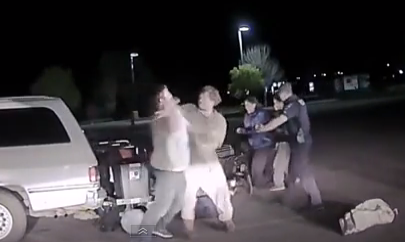
Thoughts on Taser
The Taser has been an amazing tool for law enforcement, and the successful deployments and reduced injuries nationwide far outweigh any negative aspects from falls or chemically induced deaths after a Taser deployment. However, in a melee with multiple combatants, the Taser can actually be a hinderance. Once deployed, the Taser becomes a tether for the officer, and unless that combatant can be secured in handcuffs within seconds, the chaotic circumstances of the brawl will likely prevent the Taser’s effective completion to handcuffing. Such is the case in this fight.
At the same time the Taser is deployed, an Officer is on the ground with two adversaries attacking him. He is on his back and literally in the fight of his life. The Officer is able to separate and stand up (1:29), but is immediately attacked by a third combatant who pulls him to the ground by his head. Thankfully he is able to get back up rather quickly.
The First Baton
By 1:49 one officer deploys a baton and begins striking combatants. By all measures the strikes have little effect on the hyped up and motivated combatants, but it is absolutely an appropriate level of force.
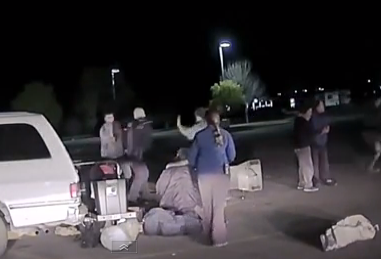
At 1.5 minutes into the fight the officers do not have one combatant in custody, fatigue is becoming apparent (on both sides thankfully), but the fight rages on.
Police Use of Force
In that incredible minute and a half the officer’s have used the following uses of force in a failed attempt to take the family into custody:
- Officer Presence – Uniformed authority
- Verbal Commands – “Get on the ground, stay down, stop resisting, get back”
- Balance Displacement – Tackles, tripping, pushing
- Soft Empty-Hand Techniques – Grabbing, deflecting, pulling
- Hard Empty-Hand Techniques – Punching, kicking, pushing
- Electronic Control Devices (ECD) – Taser
- Impact Weapons – Baton
Criminal Resistance and Assault
The Gaver Family exhibited numerous levels of resistance, including the following:
- Psychological Intimidation – Chest puffing, staring down officers, pointing fingers
- Verbal Non-Compliance – “No, you’re not going to separate me from my family”
- Passive Resistance – Dodging officers, shaking off attempts to be handcuffed
- Active Resistance – Pushing, wrestling, avoiding,
- Aggravated Active Resistance – Choke hold, tackling officers, punching, kicking.
O.C. Spray
Interestingly, the first use of O.C. spray appears to occur at about 2:30 into the video. Now I’m the first to admit that O.C. spray is one of the last options I will choose because of the inevitable likelihood of the spray to effect me and other officers during the deployment. I’ve been the recipient of such unwanted exposure and in a fight like this one I want nothing to do with that fire!
As you can see in the video, one for the most combative family members starts to wipe his eyes, and back away at about the 2:30 mark, in an apparent reaction to being sprayed by O.C. spray. The use of force can go up and down, and I don’t fault these officers at all by their attempt to use another less lethal force option to gain compliance and control over these assailants. Unfortunately, it too seems to have limited effect on the family bent on fighting the police.
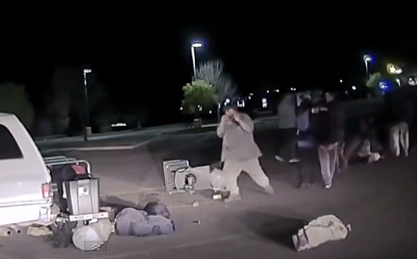
O.C. spray has proven to be very effective on many individuals. It’s selection as a less lethal use of force is appropriate. As the video progresses, you can see that several family members appear to be effected by the O.C. spray, but they are far from subdued. Several are still very combative.
TRAINING POINT: Rarely is one technique successful in overcoming the most determined combatants who are committed to resisting arrest. Officers should take note and make mental preparations to be ready to use multiple techniques and tools in restraining the most violent offenders.
The video up to 1:50 minutes shows police officers attempting almost every less lethal means they have available to get this family into compliance and control. The aggravated resistance of the family has blocked the officers’ attempts, and ultimately increased the level of reasonable force against them.
Deadly Force!
By 02:15 one officer has his pistol out, but decides to re-holster. For any that want to claim the officers over-reacted, or lost control, I think that level of restraint is amazing. Unfortunately, only seconds later another officer is taken to the ground by these murderous thugs are about to realize the finality of the error of their actions.
At 02:24 an officer can be heard warning, “I’ll shoot your ass”. On the right of the video an officer can be seen wrestling with at least one of the Gaver family. In the next 20 seconds that officer and one of the family members are on the ground fighting over the officer’s sidearm. A second family member joins the fight for the sidearm, and a third (one of the most aggressive males) comes over and tries to drag the officer away. Amazingly, the citizen (I believe a Wal-Mart employee) is still assisting the police, and punches the aggressive male causing him to let go of the downed officer.
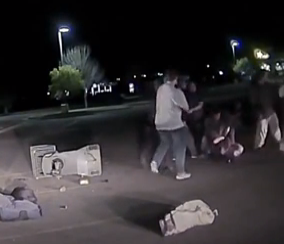
Unfortunately, the attackers efforts have been successful in loosening the officer’s grip on his gun, as can be heard at 02:59 when the officer screams, “he’s got my gun”. Another officer moves in and feverishly strikes one of the assailants with his baton, but again there appears to be little effect despite the hail mary blows to the back.
At about 03:02 it sounds like the single shot is fired during the struggle over the officer’s sidearm that strikes the officer in the upper thigh. After several more baton strikes, and pushing one of the attackers back, the assisting officer transitions to his pistol, moves in, and fires one aimed shot directly into the primary male attempting to disarm the downed officer.
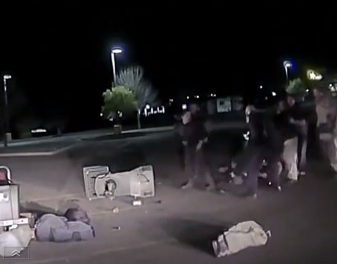
The fatal shot on the attacker trying to disarm the officer comes at 03:15, at least 13 seconds after the first shot was fired injuring the downed officer. If you’ve ever “rode the lightning” by enduring the 5-second Taser deployment for training, you know those were some of the longest seconds of your life. The downed officer had to endure (and fight) for nearly three times that long before the fatal shot was fired to release the primary attacker.
TRAINING POINT: I applaud both officers for their heroic actions in this chaotic battle. Both are obviously worn down from nearly 2.5 minutes of constant fighting. When the first officer is on the ground calling out that an attacker is going for his gun, the other officers on scene should immediately recognize that the “physical” resistance has just gone to “lethal threat”. I firmly believe that the delay in a lethal response was due to the physical exertion already expended by the officers on scene. Two officers are not even in the video, likely fighting other family members off screen. Thankfully for the downed officer, his back-up was fighting nearby and could transition in time to make the difference.
If you thought the officer shooting a family member would bring an end to the fighting, think again! Watch closely and you will see that the second male family member continues to fight for the officer’s weapon for 17 seconds, until the downed officer is able to forcibly pull his firearm away at 03:30. The downed officer is able to show an amazingly level of clarity and restraint as he points his firearm at approaching family members but does not fire.
Sometime during the melee, and around the time of the fatal shot, another Gaver male is shot in the stomach. Still, other family members continue to fight and resist.
It is not until around 04:15, when additional officers arrive, the officers are able to use team tactics to take family members to the ground in an attempt to secure them in handcuffs. Amazingly, the family is still amped up for a fight and the males are able to break free and continue fighting!
Trauma Care
At the same time the backing officers arrive, one officer recognizes the traumatic injury to the officer who had been shot in the leg, and begins to administer life-saving first aid. The officer did a great job in cutting away the injured officer’s pants leg, and removing the boot and sock. He then goes about applying a pressure bandage to the wound.
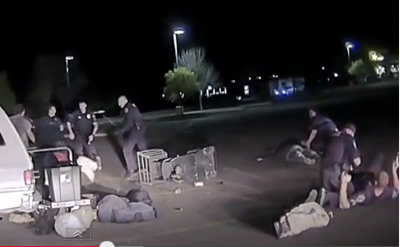
Th BlueSheepDog Crew are adamant believers in trauma care for officers, and have advocated officers carrying trauma kits or supplies (including tourniquets and pressure bandages) for a long time. Offices should carry the essential trauma care tools on their person so they are readily available. It is clear, that the aiding officer is prepared in just this manner. This officers actions likely saved the wounded officers life, however a training point should be considered.
TRAINING POINT: One of the tenants of TCCC is that the scene must be secured as much as possible before trauma care is initiated. This is due to the understood fact that if the hostilities are continuing, removing a firearm from the battle will likely result in more casualties. The concept is to eliminate the threat first (as much as practical) and then initiate life-saving measures. Here the entire family was still unsecured and actively resisting. Removing an officer (even to care for a wounded officer) hindered the ability of the other officers in resolving the battle.
This is the only critique I would offer, and I emphasize it is a minor one. The aiding officer’s heart was in the right place (helping a wounded brother), but his removal from the fight could have had disastrous effects. Even with at least two backing officers arriving the family was able to fight off the officer and continue to battle.
At 05:17 two family members actually aggressively approach the downed officer and the officer providing care. This compels both officers to draw their weapons and threaten to shoot the males if they don’t move away. Amazingly, once the initial threat is resolved and the aiding officer goes back to placing a pressure bandage, the wounded officer can be seen standing at the ready with his sidearm.
TRAINING POINT: Even when officers are wounded we should attempt to keep them “in the fight”. That may mean that they are keeping direct pressure on their own wound while we take care of other threats, or giving them a task (like staying armed and aware) while aid is being provided. If the officer is in a mental condition that allows for it, the best thing you can do is keep them occupied with other things than their injury.
It is not until nearly (7) minutes into the video before officers appear to be able to secure family members into handcuffs and somewhat get the scene under control. By that time, and with the assistance of other supportive citizens, the wounded officer is moved to a patrol car to be removed from the scene to an awaiting ambulance.
Lessons Learned!
By any review of this video, it is clear that the Gaver family is not some innocent family accosted by the police, but instead, a family committed to violence (Wal-Mart employees), resistance, and assault on police officers. In these situations the mob mentality is at its worst, because each of the participants is intimately involved with the other participants. This video brought back haunting images from the video showing the murder of two West Memphis Police officers by a father and son sovereign citizen duo.
Anyone reviewing this altercation should remember that the introduction of police was not by some self-initiated police action, but instead by the call for assistance by the Wal-Mart employees who had been assaulted. This family felt they were above the law, and could accost Wal-Mart employees at their own will. The police officers confronting them were merely an obstruction to this family’s wanton desire to do as they pleased, without any recourse.
Officers should remember that numbers alone are not a safety blanket. It requires officers to use sound tactics, isolate combatants, and secure offenders in handcuffs as quickly as possible. The original four officers were in the fight of their life, and the uncoordinated actions (compounded with an organized resistance) led each officer to fight his own battle.
The adage – “work smarter, not harder” is something that every officer should work into their mindset and tactical training.
It is interesting to point out that the combatants had begun called the officers “nazis”, and when the baton is deployed one of the male family members screams “you’re hitting children”. This is despite the fact that all of the combatants were adults, except for one juvenile female (that was almost an adult) who was not even involved in the actual physical altercation.
This is just the stuff the media loves to cling to for a story, so when you’re involved in a situation like this you need to painstakingly detail in your report as much of the actions you can remember and more importantly, “why” you did them.
Final Thoughts
Despite initial setbacks, these officers did a very good job in incredibly difficult circumstances. The use of force remained well into the lower levels for nearly 1.5 minutes before a baton was introduced. Even then strikes were not wildly thrown, but deliberately delivered to critical times on specific combatants.
The use of O.C. was brought in a little late to the game, but did seem to have some effect – though not enough to stop the Gaver men from continuing their fight. Once additional officers arrived, more coordinated attempts to take the Gaver men into custody were used, and ultimately successful after a couple more minutes of chaotic fighting.
In any fatal shooting, or prolonged use of force, officers must be particularly keen in making a detailed report of their actions. Nobody could expect an officer to remember all of the details chronologically in a fight like this. The video can be reviewed to assist officers’ memory, and to ensure that all the correct details are included.
In addition, officers should include their fears, concerns, the attacks upon them, the types and levels of resistance, and anything else that can more clearly paint a picture of the rabid resistance they were face with. Just because there is a video, there is no excuse for not making a highly detailed report to explain the officers’ actions. Thankfully, the video makes this one very clear indeed.